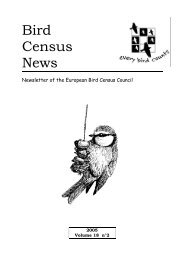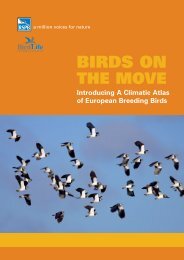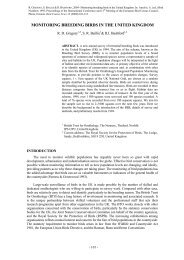Quantifying the impact of land-use change to European farmland ...
Quantifying the impact of land-use change to European farmland ...
Quantifying the impact of land-use change to European farmland ...
Create successful ePaper yourself
Turn your PDF publications into a flip-book with our unique Google optimized e-Paper software.
354 S.J. Butler et al. / Agriculture, Ecosystems and Environment 137 (2010) 348–357<br />
Table 2<br />
The relative distribution <strong>of</strong> risk accrued from different sources.<br />
Landscape component a Source <strong>of</strong> risk Proportion <strong>of</strong> <strong>to</strong>tal risk accrued<br />
BASIC framework SCALE framework<br />
Crop Reduction in quantity or quality <strong>of</strong> food resources 0.59 0.59<br />
Reduction in nest site availability and success 0.19 0.18<br />
Margin Reduction in quantity or quality <strong>of</strong> food resources 0.10 0.11<br />
Reduction in nest site availability and success 0.05 0.05<br />
Hedgerow Reduction in quantity or quality <strong>of</strong> food resources 0.03 0.03<br />
Reduction in nest site availability and success 0.04 0.04<br />
a ‘Crop’ refers <strong>to</strong> cropped areas <strong>of</strong> <strong>the</strong> <strong>land</strong>scape ra<strong>the</strong>r than <strong>the</strong> actual crop itself, ‘margin’ refers <strong>to</strong> non-cropped open habitats in <strong>the</strong> <strong>land</strong>scape and ‘hedge’ refers <strong>to</strong><br />
structural vegetation elements in <strong>the</strong> <strong>land</strong>scape such as hedgerows and trees.<br />
Table 3<br />
Relative contribution <strong>of</strong> <strong>the</strong> twenty countries that provide data for <strong>the</strong> EFBI <strong>to</strong> its 2005 level, based on <strong>the</strong> proportion <strong>of</strong> risk accrued by each EFBI species in each country.<br />
RANK BASIC framework SCALE framework<br />
Country Proportion <strong>of</strong> <strong>to</strong>tal risk (%) Country Proportion <strong>of</strong> <strong>to</strong>tal risk (%)<br />
1 Spain 37.82 Spain 41.23<br />
2 Po<strong>land</strong> 11.82 France 13.96<br />
3 France 11.62 Germany 8.07<br />
4 Italy 5.78 United Kingdom 7.20<br />
5 Hungary 5.75 Italy 6.63<br />
6 United Kingdom 4.96 Hol<strong>land</strong> 4.51<br />
7 Germany 4.46 Po<strong>land</strong> 4.23<br />
8 Hol<strong>land</strong> 3.54 Portugal 3.22<br />
9 Portugal 2.80 Denmark 1.81<br />
10 Fin<strong>land</strong> 2.08 Fin<strong>land</strong> 1.79<br />
11 Latvia 1.60 Hungary 1.37<br />
12 Sweden 1.56 Ire<strong>land</strong> 1.31<br />
13 Czech Republic 1.53 Sweden 1.03<br />
14 Denmark 1.05 Austria 0.78<br />
15 Ire<strong>land</strong> 0.98 Belgium 0.57<br />
16 Norway 0.91 Switzer<strong>land</strong> 0.56<br />
17 Es<strong>to</strong>nia 0.66 Latvia 0.55<br />
18 Austria 0.44 Norway 0.54<br />
19 Belgium 0.36 Czech Republic 0.40<br />
20 Switzer<strong>land</strong> 0.29 Es<strong>to</strong>nia 0.22<br />
3.4. Impacts <strong>of</strong> <strong>land</strong>-<strong>use</strong> <strong>change</strong> scenarios on EFBI<br />
Our models predicted that <strong>the</strong> EFBI will continue declining if<br />
current conditions persist across <strong>European</strong> agricultural <strong>land</strong>scapes.<br />
By 2020, it was predicted <strong>to</strong> fall by around a quarter <strong>to</strong> between<br />
0.41 and 0.50, depending on <strong>the</strong> model <strong>of</strong> population growth rate<br />
<strong>use</strong>d (Table 4). Each <strong>of</strong> <strong>the</strong> o<strong>the</strong>r scenarios explored introduced<br />
additional risk in<strong>to</strong> <strong>the</strong> agricultural <strong>land</strong>scapes, by reducing <strong>the</strong><br />
abundance and/or availability <strong>of</strong> key resources, and <strong>the</strong> predicted<br />
EFBI in 2020 under all three was <strong>the</strong>refore lower than that predicted<br />
if current conditions were <strong>to</strong> persist. In light <strong>of</strong> <strong>the</strong> loss <strong>of</strong><br />
compulsory set-aside, 43 <strong>of</strong> <strong>the</strong> species included in <strong>the</strong>se analyses,<br />
including 28 <strong>of</strong> <strong>the</strong> 33 EFBI species, can be expected <strong>to</strong> experience<br />
reduced population growth rates. Indeed, <strong>the</strong> predicted EFBI<br />
in 2020 under this scenario was 8% lower than that predicted if<br />
current conditions persist. Accelerated agricultural intensification<br />
in east Europe was predicted <strong>to</strong> have a large detrimental <strong>impact</strong><br />
on <strong>the</strong> EFBI, with 2020 levels expected <strong>to</strong> be between 20% and 25%<br />
lower under this scenario than if current conditions persist. Higher<br />
rates <strong>of</strong> <strong>land</strong> abandonment led <strong>to</strong> greater reductions in <strong>the</strong> EFBI,<br />
with each 5% decline in <strong>the</strong> UAA predicted <strong>to</strong> ca<strong>use</strong> a 2–2.5% lowering<br />
<strong>of</strong> <strong>the</strong> EFBI by 2020 (Table 4). Details <strong>of</strong> <strong>the</strong> predicted population<br />
growth rate for each species under each scenario are provided in<br />
Table S10, Supplementary data in <strong>the</strong> SOM.<br />
Table 4<br />
Predicted EFBI in 2020 derived from risk scores associated with continued current management (Scenario 1), <strong>the</strong> loss <strong>of</strong> compulsory set-aside (Scenario 2), accelerated<br />
agricultural intensification in east Europe (Scenario 3) and continued <strong>land</strong> abandonment (Scenario 4). Mean predicted EFBI values and 95% confidence limits (in paren<strong>the</strong>ses)<br />
were generated from three alternative models <strong>of</strong> population growth rate (see text for details). The predicted EFBI for 2005, generated from <strong>the</strong> three alternative models, is<br />
also shown. For comparison, <strong>the</strong> EFBI in 2005 calculated from actual population growth rates was 0.64.<br />
Model Predicted EFBI in<br />
2005<br />
Predicted EFBI in 2020<br />
Scenario 1 Scenario 2 Scenario 3 Scenario 4<br />
5% loss <strong>of</strong> UAA 10% loss <strong>of</strong> UAA 15% loss <strong>of</strong> UAA<br />
BASIC – <strong>to</strong>tal risk 0.65 (0.52–0.81) 0.50 (0.37–0.63) 0.46 (0.34–0.60) – – – –<br />
SCALE – <strong>to</strong>tal risk 0.66 (0.52–0.83) 0.50 (0.38–0.64) – 0.39 (0.30–0.51) 0.48 (0.37–0.64) 0.47 (0.34–0.62) 0.46 (0.34–0.60)<br />
SCALE –<br />
diet-related risk<br />
plus nest related<br />
risk<br />
0.60 (0.47–0.74) 0.41 (0.31–0.55) – 0.30 (0.23–0.39) 0.40 (0.30–0.53) 0.39 (0.29–0.52) 0.38 (0.29–0.49)






